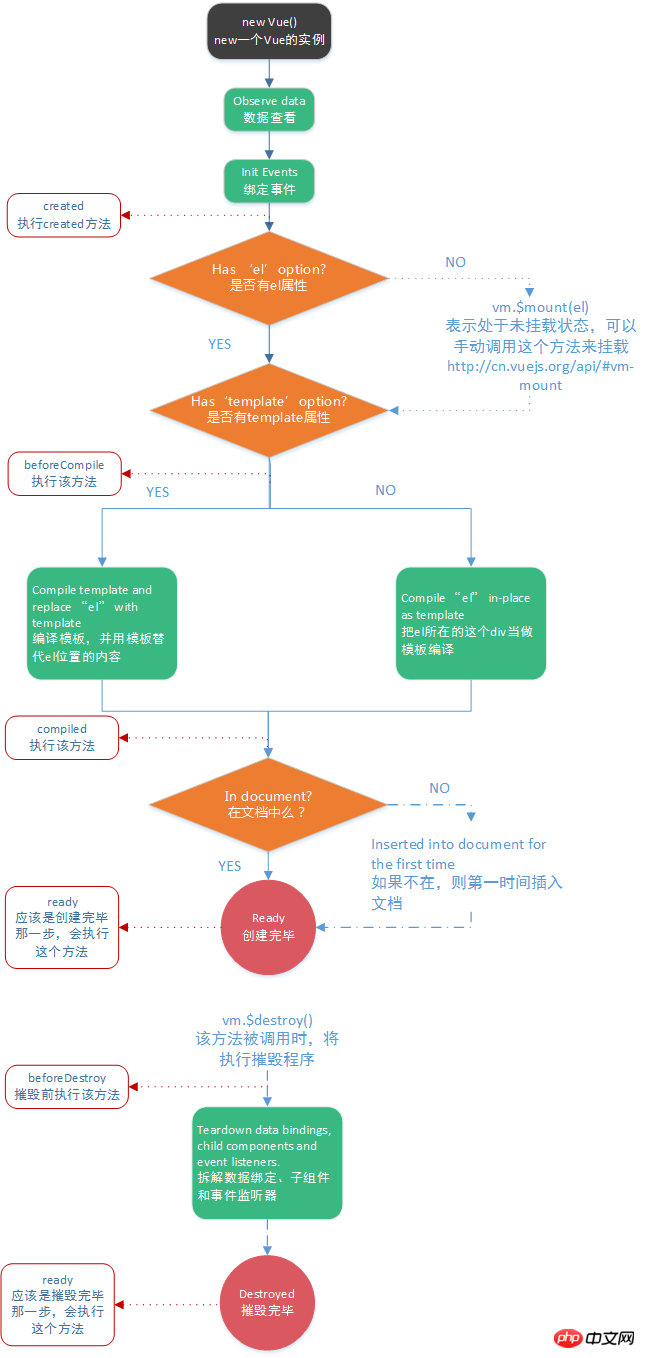
This article mainly introduces the knowledge related to the life cycle of Vue components and Route. Friends who need it can refer to it
Let’s talk about some practical things first
Practical Point hook:
Created: A life cycle hook function after the vue instance is generated. (Page initialization data loading is generally written here);
beforeCreate: Give a loading interface created to cancel loading;
beforeDestory: Are you sure to delete XX?
destoryed: The current component has been deleted and the related content has been cleared
About the Vue component life cycle, the translated icon:

module.exports = {
//props: ['父组建传的值'],
data:function(){
lifecycle.push("data");
return {
msg: '各个阶段,可以查看控制台输出,message from my-views',
title:'my_views',
lifecycle: lifecycle
}
},
//这里是route的生存周期
route:{
//waitForData: true, // 数据加载完毕后再切换试图,也就是 点击之后先没反应,然后数据加载完,再出发过渡效果
canActivate:function(transition){
// canActivate阶段,可以做一些用户验证的事情(是否可以被激活)
// 在验证阶段,当一个组件将要被切入的时候被调用。
},
activate:function(transition){
// 在激活阶段被调用,在 activate 被断定( resolved ,指该函数返回的 promise 被 resolve )。用于加载和设置当前组件的数据。(激活)
//this.$root.$set('header',this.title);
transition.next();
//此方法结束后,api会调用afterActivate 方法
//在aftefActivate中 会给组件添加 $loadingRouteData 属性 并设置为true
},
data: function(transition) {
var _this = this;
// 在激活阶段被调用,在 activate 被断定( resolved ,指该函数返回的 promise 被 resolve )。用于加载和设置当前组件的数据
// 说明之前请求过 则不用再请求了
if(this.$root.myViewsData){
this.$data = this.$root.myViewsData;
transition.next();
console.log('已经请求过了不再请求数据');
return;
}
//将数据同步到根节点
this.$root.myViewsData = this.$data;
setTimeout(function(){
//这里 _this.$loadingRouteData 是 true
transition.next({msg:'加载后的数据'});
//在调用完transition.next 后,_this.$loadingRouteData 为 false
}.bind(this),4000);
},
canDeactivate:function(transition){
// 在验证阶段,当一个组件将要被切出的时候被调用。(是否可以被禁用)
},
deactivate: function (transition) {
// 在激活阶段,当一个组件将要被禁用和移除之时被调用。(禁用)
}
},
beforeCreate:function(){
// 在实例初始化之后,数据观测(data observer) 和 event/watcher 事件配置之前被调用。
},
created:function(){
// 实例已经创建完成之后被调用。在这一步,实例已完成以下的配置:数据观测(data observer),属性和方法的运算, watch/event 事件回调。然而,挂载阶段还没开始,$el 属性目前不可见。
},
beforeCreate:function(){
// 在实例初始化之后,数据观测(data observer) 和 event/watcher 事件配置之前被调用。
},
mounted:function(){
// el 被新创建的 vm.$el 替换,并挂载到实例上去之后调用该钩子。如果 root 实例挂载了一个文档内元素,当 mounted 被调用时 vm.$el 也在文档内。
},
beforeUpdate: function(){
// 数据更新时调用,发生在虚拟 DOM 重新渲染和打补丁之前。
// 你可以在这个钩子中进一步地更改状态,这不会触发附加的重渲染过程。
},
updated: function(){
// 由于数据更改导致的虚拟 DOM 重新渲染和打补丁,在这之后会调用该钩子。
//当这个钩子被调用时,组件 DOM 已经更新,所以你现在可以执行依赖于 DOM 的操作。然而在大多数情况下,你应该避免在此期间更改状态,因为这可能会导致更新无限循环。
},
// <keep-alive> 包裹动态组件时,会缓存不活动的组件实例,而不是销毁它们。
activated: function(){
// keep-alive 组件激活时调用。
},
deactivated: function(){
// keep-alive 组件停用时调用。
},
beforeDestroy:function(){
// 实例销毁之前调用。在这一步,实例仍然完全可用。
},
destroyed:function(){
// Vue 实例销毁后调用。调用后,Vue 实例指示的所有东西都会解绑定,所有的事件监听器会被移除,所有的子实例也会被销毁。
}
}The above is what I compiled for everyone. I hope it will be helpful to everyone in the future.
Related articles:
Returning non-callback methods through WebView processing in react-native
Using Elememt-UI build management in Vue Backend (detailed tutorial)
What are the methods of using isPlainObject() in jQuery?
The above is the detailed content of The life cycle of Vue components and Route (detailed tutorial). For more information, please follow other related articles on the PHP Chinese website!




